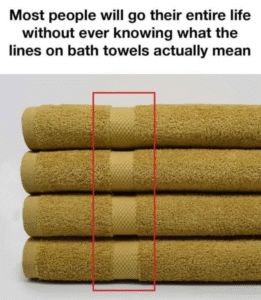
The Real Purpose of Those Mysterious Lines on Towels—Revealed
If you’ve ever unfolded a brand-new towel or taken a closer look at the ones stacked neatly in your bathroom, you’ve probably noticed them: those subtle, often decorative-looking lines or bands that run across one or both ends of the towel. Most people assume they’re just a design choice, maybe a bit of aesthetic flair. But what if we told you those mysterious lines actually serve a surprising and practical purpose?
These horizontal lines are known as dobby borders, and they’ve been quietly doing more than just decorating your towels for decades.
At first glance, a dobby border looks like a slightly different weave—thinner, flatter, and often shinier than the rest of the towel’s plush, looped surface. While many manufacturers do use it to add a visual contrast, the design originated from a loom technique called the dobby weave, which allows for the creation of simple geometric patterns without interrupting the structural integrity of the fabric.
But beyond aesthetics, the dobby border actually plays an important functional role.
Towels, especially high-quality cotton ones, undergo a lot of stress: from repeated washings to constant pulling, wringing, and folding. The main body of a towel is made with terry loops—those little fabric loops that are designed to absorb water. But because terry loops are also flexible and soft, they can be vulnerable to unraveling or losing shape over time.
Enter the dobby border.
This tighter, flatter weave helps stabilize the towel’s shape and prevent the edges from curling or fraying. It acts almost like a frame or anchor, maintaining structure through countless spins in the washer and dryer. Some textiles experts even describe the border as a kind of reinforcement band, ensuring that the towel doesn’t stretch unevenly or twist after multiple uses.
But there’s more. For manufacturers, the dobby border also serves as a break in the production process—a visual and technical cue that signals the end of the towel length before cutting and hemming. Think of it as a built-in guide for precision during mass production.
And for consumers? It turns out the dobby border has one final, unexpected benefit: it can be used as a quick tactile guide when folding. Since the texture differs from the rest of the towel, some people subconsciously use the border to align folds more neatly—an unintentional design bonus that adds a touch of order to your linen closet.
So, the next time you hang up your towel or fold it neatly onto a shelf, take a moment to appreciate those understated lines. Far from being just decoration, they’re a small marvel of textile engineering—balancing function, durability, and design in a way most of us never even notice.
